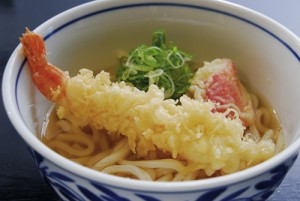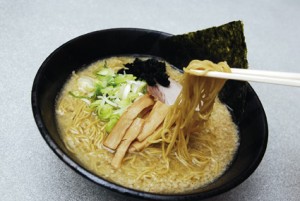Q: What’s the difference between spaghetti and Asian noodles?
Marco Polo’s small travel guide has forever been the subject of much debate: did he actually go to China? And (as a Spanish friend suspects) did the Italians gain the idea for spaghetti from some noodles that Marco brought back from far Cathay (if, indeed, he did go there)?
In fact, historians are aware that pasta has been around since Roman times, but the question of who invented what first was decisively answered two years ago when an archaeological team in China dug up noodles which were 4,000 years old.
This being the case, we see little reason why cognoscenti of pasta should remain ignorant of its older brethren in Asia – more specifically, in this case, Japan. ….Noodles are noodles, right? (There was a time, back when dinosaurs walked the earth, that the only pasta everyone knew of was spaghetti).††
To list just a few kinds: we’ll start with Udon. This is a thick, wheat-based noodle, thought of as Japanese; (although Kukai, a Buddhist monk, is said to have brought it from China, back in the 9th century). The broth in which these noodles are served is very mild, being made from Japanese dashi (fish and seaweed) stock, shoyu sauce and mirin. A large variety of toppings are available, such as tempura, egg, tofu, or Japanese curry to mention just a few. Udon may also be served fried, with vegetables.†
This is a thick, wheat-based noodle, thought of as Japanese; (although Kukai, a Buddhist monk, is said to have brought it from China, back in the 9th century). The broth in which these noodles are served is very mild, being made from Japanese dashi (fish and seaweed) stock, shoyu sauce and mirin. A large variety of toppings are available, such as tempura, egg, tofu, or Japanese curry to mention just a few. Udon may also be served fried, with vegetables.†
Soba, is a thin, Japanese style of noodle made from buckwheat. One of the classic ways of consuming it is as a refreshing dish in high summer: the noodles come served on a bamboo zaru tray, and are placed in a bowl of water chilled with ice cubes; the noodles are then dipped into a cold sauce of dashi, shoyu sauce and mirin, mixed with wasabi, grated ginger, and chopped spring onions. Somen noodles Å| made from wheat, but even thinner and smaller Å| are eaten in the same manner. Served hot, soba noodles are often prepared in ways which are similar to udon. (Incidentally, udon may also be served cold, in summer, in the same manner as soba and somen).
 Then there is Ramen. Chinese in origin, this noodle, made from wheat flour, water and salt, is eaten in a chicken or pork-based stock, and topped with a sliver of pork and chopped spring onions. There are many regional varieties of this staple, and our local ramen-ya-sans, Tanpopo and Ichiban Ramen, have at least nine different kinds on their menus.
Then there is Ramen. Chinese in origin, this noodle, made from wheat flour, water and salt, is eaten in a chicken or pork-based stock, and topped with a sliver of pork and chopped spring onions. There are many regional varieties of this staple, and our local ramen-ya-sans, Tanpopo and Ichiban Ramen, have at least nine different kinds on their menus.
They are the Japanese businessman’s favourite prophylactic against a hangover. Walk down the street in any Japanese city, and you are likely to see the ubiquitous red streetside tents serving ramen to guys, not just in their cups, but probably well staring into the bottom of them. Some of the more popular versions are:
- Shoyu ramen
The broth for this has a shoyu-sauce base. It is a thin, and relatively transparent dark soup. This form of ramen is most popular, and common, in the Kanto region of Japan; (Japanese people traditionally divide their country into two halves: Kanto (east) and Kansai (west), as opposed to north and south). Often some basic differences of taste in food can correspond to these two regions.
- Miso ramen
This regional style of ramen first gained popularity as recently as 1965-in Sapporo, the capital of Hokkaido, the northernmost of Japan’s four main islands. This is not miso soup; rather, it is miso (fermented bean paste) dissolved in a broth of dashi (Japanese stock). Since Hokkaido is also the center of Japan’s dairying industry, this ramen is often topped with a pat of butter – and sweetcorn, too.
- Tonkotsu ramen
A speciality of Kyushu. The name tonkotsu is derived from ton (pork) and kotsu (bone). The broth is made from boiling crushed pork bones for several hours. This colours and thickens the broth, and gives it a richness greater than the two other styles of ramen. Similar to the Chinese soup baitang. (The Kansai region’s food tastes are more clearly influenced by the Asian mainland, than the Kanto region’s are).

